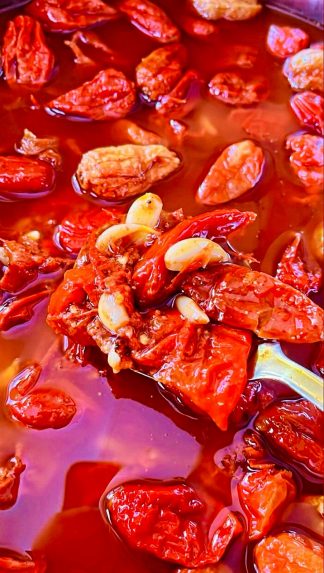
Rhododendrons, often admired for their vibrant blooms, hold a secret arsenal of culinary and medicinal properties. This post delves into the lesser-known edible aspects of rhododendrons and their intriguing health benefits.
Culinary Adventures with Rhododendrons
In the Himalayan hillsides, rhododendron trees paint the landscape with their bright red flowers. These aren’t just visual treats; they’re culinary gems. The flowers are traditionally transformed into a variety of products:
- Rhododendron Chutney: A tangy concoction made by crushing the flowers and blending them with herbs and spices. This chutney is a burst of flavor, combining the floral notes with a sour edge.
- Rhododendron Juice: Prepared using age-old mountain recipes, this juice is a healthy, although often sweetened, beverage. It’s made by extracting the juice from the petals, often preserved with organic sugar and lemon juice.
- Rhododendron Honey: Known as mad, wild, or toxic honey, this variety is produced by bees that forage on rhododendron flowers. While it offers antibacterial, antifungal, and antioxidant properties, caution is advised due to its content of grayanotoxin.
Health Benefits: Beyond Beauty
Rhododendrons are not just about aesthetics; they pack a punch of health benefits:
- Antimicrobial Properties: The flowers contain bioactive steroids and phytochemicals effective against various bacteria strains.
- Boosting Immunity: Locals consume rhododendron petals to strengthen the immune response, lowering the risk of allergies and respiratory ailments.
- Liver Health: Used in Ayurveda as a liver tonic, rhododendron flowers are known for their hepatoprotective properties, thanks to compounds like Quercetin.
- Cancer Prevention: The presence of antioxidants like Quercetin and Rutin in rhododendron helps prevent oxidative damage to cells, reducing cancer risk.
- Cardiovascular Benefits: Studies suggest that rhododendron extracts can improve heart health by reducing serum lipid levels and improving antioxidant activity.
- Weight Management: Some species have shown potential in reducing body weight gain and adipose tissue weight, beneficial in managing obesity.
- Cognitive Function Improvement: Compounds in rhododendrons may enhance cognitive functions like memory and learning ability.
Precautions and Sustainability
While exploring the edible and medicinal uses of rhododendrons, it’s crucial to differentiate between safe and toxic varieties. Sustainable harvesting and preparation are key, as the plant remains underutilized and requires more research for its conservation and broader utilization in the food and pharmaceutical industries.
Conclusion
Rhododendrons, with their hidden secrets and benefits, offer a world of possibilities for culinary enthusiasts and health-conscious individuals. As we continue to uncover these floral wonders, they remind us of the intricate connection between nature and our well-being. Remember, moderation and informed consumption are key to enjoying the full spectrum of benefits these magnificent blooms offer.
FAQs on Rhododendron – Hidden Secrets and Benefits
1. Can all rhododendron species be used for edible purposes?
- No, not all rhododendron species are edible. Some contain toxic compounds, so it’s crucial to identify the right species and use safe preparation methods.
2. What are the known health benefits of consuming rhododendron products?
- Rhododendron products are known for their antimicrobial properties, ability to boost immunity, support liver health, and potentially prevent cancer. They also may offer cardiovascular benefits and aid in weight management.
3. Is rhododendron honey safe to consume?
- Yes, but in moderation. Rhododendron honey contains grayanotoxin, which can be harmful in large quantities. It’s best to consume it under guidance and in small amounts.
4. How is rhododendron chutney made?
- Rhododendron chutney is made by crushing the flowers and adding ingredients like mint leaves, salt, anardana, or tamarind for a sour taste.
5. Can rhododendron juice help in weight management?
- Some studies suggest that rhododendron may have anti-obesity effects, but more research is needed to confirm its efficacy in weight management.
6. Are there any risks associated with consuming rhododendron products?
- Consuming the wrong species or excessive amounts of rhododendron products, especially honey, can be harmful. It’s important to use them responsibly and be aware of potential side effects.
7. How does rhododendron support cardiovascular health?
- Rhododendron species have been found to reduce serum lipid levels and improve antioxidant activity, which can be beneficial for heart health.
8. Can rhododendron be used in skincare products?
- Yes, rhododendron extracts are sometimes used in skincare products due to their anti-inflammatory and antibacterial properties.
9. Is there any scientific research backing the medicinal use of rhododendron?
- Yes, there have been various studies investigating the medicinal properties of rhododendron, including its antimicrobial, anti-inflammatory, and cardioprotective effects.
10. How can I safely incorporate rhododendron into my diet?
- Start with commercially available rhododendron products like juice or chutney from reputable sources. Always consume in moderation and consult with a healthcare provider if you have health concerns.
Blog Tags
rhododendron, edible flowers, herbal remedies, natural health, Himalayan cuisine, floral chutneys, medicinal honey, heart health, traditional medicine, sustainable harvesting








